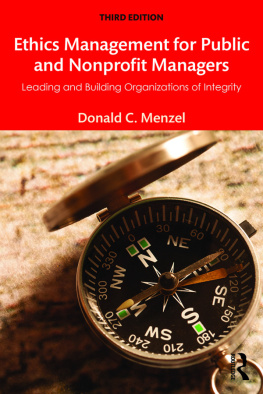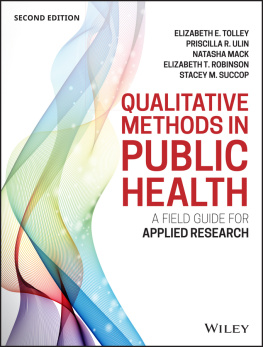Practical Research Methods for Nonprofit and Public Administrators
Practical Research Methods for Nonprofit and Public Administrators
ELIZABETHANN OSULLIVAN
North Carolina State University
GARY R. RASSEL
University of North Carolina-Charlotte
JOCELYN DEVANCE TALIAFERRO
North Carolina State University
First published 2011 by Pearson Education, Inc.
Published 2016 by Routledge
2 Park Square, Milton Park, Abingdon, Oxon OX14 4RN
711 Third Avenue, New York, NY, 10017, USA
Routledge is an imprint of the Taylor & Francis Group, an informa business
Copyright 2011 Taylor & Francis. All rights reserved.
All rights reserved. No part of this book may be reprinted or reproduced or utilised in any form or by any electronic, mechanical, or other means, now known or hereafter invented, including photocopying and recording, or in any information storage or retrieval system, without permission in writing from the publishers.
Notice:
Product or corporate names may be trademarks or registered trademarks, and are used only for identification and explanation without intent to infringe.
ISBN-13: 978-0-205-63946-5 (pbk)
Cover Design Manager: Jayne Conte
Cover Designer: Suzanne Duda
Library of Congress Cataloging-in-Publication Data
OSullivan, Elizabethann.
Practical research methods for nonprofit and public administrators / Elizabethann OSullivan, Gary R. Rassel, Jocelyn DeVance Taliaferro.
p. cm.
Includes index.
ISBN-13: 978-0-205-63946-5
1. Human servicesResearchMethodology. 2. Social serviceResearchMethodology. 3. Nonprofit organizationsResearchMethodology. 4. Public administrationResearchMethodology. I. Rassel, Gary Raymond. II. Taliaferro, Jocelyn DeVance. III. Title.
HV11.O79 2011
001.4'2dc22
2010032090
TABLE OF CONTENTS
CHAPTER 1
Research in Public and Nonprofit Programs: The Basics
CHAPTER 2
Measurement
CHAPTER 3
Ethical Treatment of Research Subjects
CHAPTER 4
Designing Performance Measures and Monitoring Systems
CHAPTER 5
Analyzing Performance Measures
CHAPTER 6
Selecting and Contacting Subjects
CHAPTER 7
Questions and Questionnaire for Surveys and Interviews
CHAPTER 8
Analyzing Survey Data: Describing Relationships Among Variables
CHAPTER 9
Generalizing from Survey Findings: Applying Inferential Statistics
CHAPTER 10
Analyzing Interviews and Open-Ended Questions
CHAPTER 11
Research to Evaluate Programs
CHAPTER 12
Community Needs Assessment
CHAPTER 13
Working with Geographic Information Systems
CHAPTER 14
Communicating Findings
I magine how disheartened we were when students told us how much they learned in their research methods class, but they did not think that it would be relevant to their careers. We suppressed the urge to say, But you will use it all the time. Students may not realize how relevant research methods will be in their careers, and administrators may not appreciate when they are applying research skills. If we are right, leaders and staff in public and nonprofit organizations are missing opportunities to use research information effectively and efficiently. We immediately saw the need to explicitly link management applications and research methodology, which led to this text.
In writing this book we included four innovations to demonstrate the link between methodology and professional practice. First, we integrate traditional research methods topics with specific management applications. Second, we include extensive exercises, which require students to apply each methodology. Third, we limit the methodological details to the key concepts that administrators and managers use most often. Fourth, we acknowledge the importance of qualitative methods and emphasize practical skills that managers should be able to easily and correctly apply.
The senior authors, Elizabethann OSullivan and Gary Rassel, have written together for over 25 years. This text includes a third author, Jocelyn Taliaferro. Jocelyn brings in the point of view of another discipline, social work, which complements our backgrounds in public and nonprofit management. More importantly, she is a trained qualitative analyst. Her voice in the book should encourage you to see the value of these methods, to use them correctly, and get the greatest value of the information they provide. Jocelyns participation in writing this text makes it truly interdisciplinary and relevant to professionals who come from a variety of academic backgrounds.
Social science and policy researchers rely on measurement, sampling, and research designs to create and conduct their research. In addition, they must apply statistics and other analytical procedures to analyze and interpret the information they collect. All the management tools we selected require measurement, sampling, and a choice of a research design, but one or two methodologies dominate each tool. Consequently, we organized this text around management tools that rely heavily on methodology: performance measurement and monitoring, citizen and client surveys, program evaluation, and needs assessments. For each tool we also introduce the basic statistics used to organize and interpret the data.
The exercises are our central pedagogical tool. We have observed that students learn more from hands-on applications than they do from lectures. Plus, the exercises provide immediate feedback about what is understood and what is unclear. We divided the exercises into two or three parts: Getting Started, Small Group Exercises, and On Your Own. Getting Started asks students to apply the information presented in the chapter to management situations or policy problems. The Small Group or Class Exercises mirror what happens in most research projects, that is, each individual participant has ideas about what the research question is, why it was asked, and how to answer it. Exchanging and challenging ideas and resolving differences are critical to effective studies. The opportunity to practice these skills should be valuable in students future careers. As for now, students will find that as they try to explain their ideas, listen to others ideas, and incorporate different insights they will understand the methodology better. An On Your Own exercise is included in most chapters. This part of the exercises guides students who are working or have an internship through the steps required to apply the methodology in the field.
Our hardest decisions were how much detail to include. Our discussions of the management tools are limitedone cant begin to learn everything in one course. In the methodology chapters we did not cover the more technical details. We assumed that readers who plan careers as researchers or policy analysts will take advanced courses in methodology and statistics. We confined ourselves to covering the information needed to be an effective manager.
Including qualitative methods in a methodology text may not seem unique, but instructors may often skip the qualitative chapters as they and their students focus on the quantitative components designed to produce objective, verifiable information. Quantitatively trained authors may present qualitative methods as an add-on to quantitative studies. These authors may unconsciously communicate their limited knowledge of these methods and unwittingly undermine the quality of a texts qualitative sections. A qualitatively trained author, who has been involved in writing each chapter, may better motivate the readers to undertake qualitative research or include a qualitative portion in their own investigations.








